St. John’s wort is one of the best known and most used herbal medicines in the world. And like so many of our medicinal wild plants, it’s considered a noxious weed in much of the western US.
In my county, we’re actually required to eradicate all trace of the plants on our property within 10 feet of the road or risk getting sprayed with herbicides. (BOO)
Everywhere else on our property, though, St. John’s wort is allowed to run wild. It one herb I don’t ever want to be without!
St. John’s wort is named after John the Baptist because the flowers tend to bloom around midsummer, coinciding with the day of his feast, St. John’s Day (June 24th) — previously known as the pagan festival of Walpurgisnacht or Saint Walpurgis’ Night.
In addition to its well-known antidepressant and antianxiolitic (anti-anxiety) actions, St. John’s wort is also an effective topical anti-inflammatory and analgesic, meaning it reduces or eliminates pain. It works for muscle and nerve pain, pain from arthritis, wounds, burns and other inflammatory pain complaints.
Identification
Fortunately, St. John’s wort is pretty darn easy to identify.
SJW is a shrub-like perennial that grows 2 to 3 feet tall. Its clusters of small (less than 1″) 5-petaled, bright yellow flowers are easy to spot growing in meadows, along the side of the road or in dry, gravely soils wherever there’s adequate sunlight (so pretty much everywhere). SJW’s stalkless, oblong leaves are arranged in an opposite pattern on a reddish colored stem.
Hold a leaf up to the sun to see another distinguishing characteristic of St. John’s wort. Do you see a bunch of teeny-tiny dots? Those are actually translucent oil glands that give the leaf a perforated appearance — hence its name, perforatum.
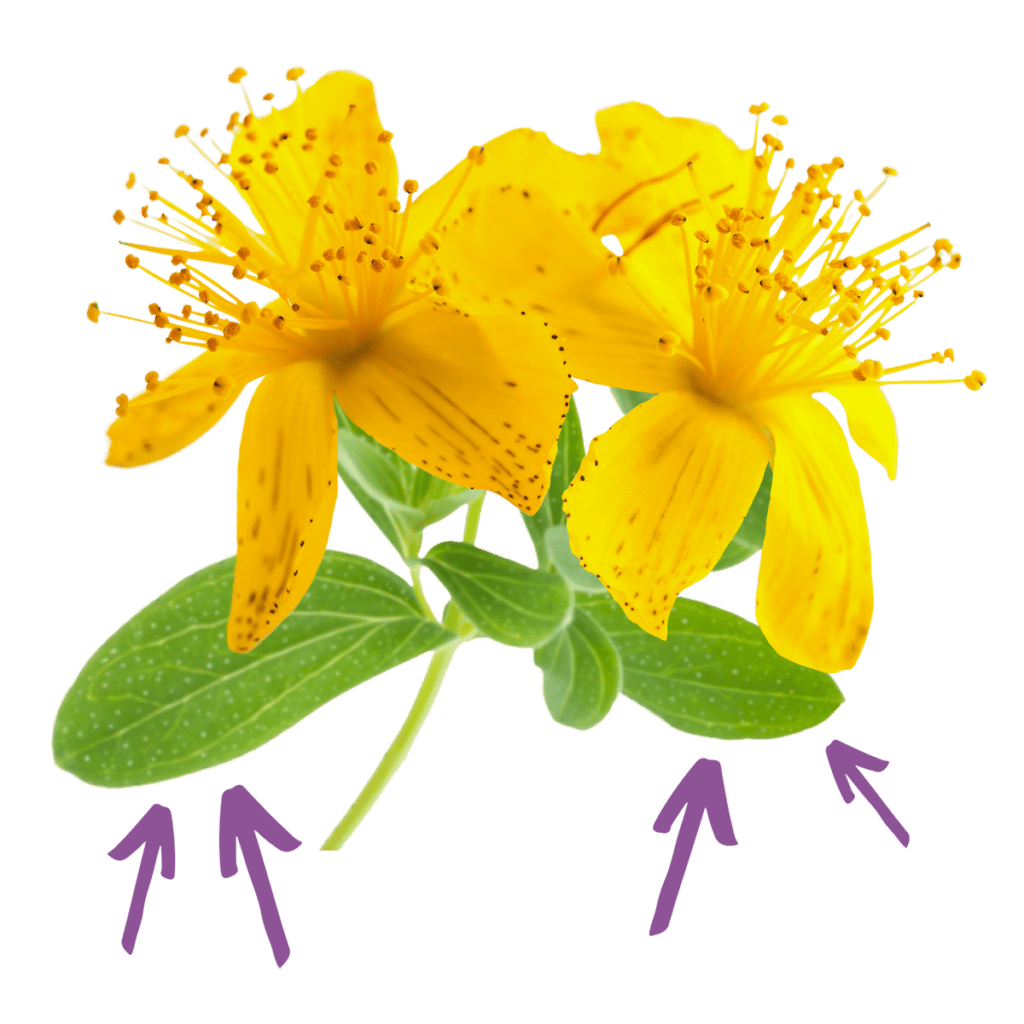
Phytochemicals
Hypericin and hyperforin are the active components of SJW that mitigate pain. According to The Journal of Pain, hypericin works by inhibiting Protein kinase C activity and hyperforin regulates the endogenous opioid system to reduce pain. Hypericin and hyperforin are also credited with SJW’s antiviral activity.
Some herbalists recommend gauging the plant’s potency by measuring the amount of hypericin. Without specialized lab equipment, its bright red pigment is the easiest thing to look for.
Testing for hypericin
An easy way to tell where a plant’s hypericin is concentrated is to start squishing things.
Pick a mature flower and roll it between your fingers, pressing the juices out of the flower. What do you see?
Now pick a mature flower BUD. Not an immature green bud, but a mature, unopened yellow bud. Roll it between your fingers. Are your fingers bright red? That’s hypericin, one of St. John’s wort’s principle constituents, and the one responsible for its magical red pigment.
The *just* opened flowers will also have higher amounts of hypericin.
Late-season seed pods will contain higher amounts of hyperforin.
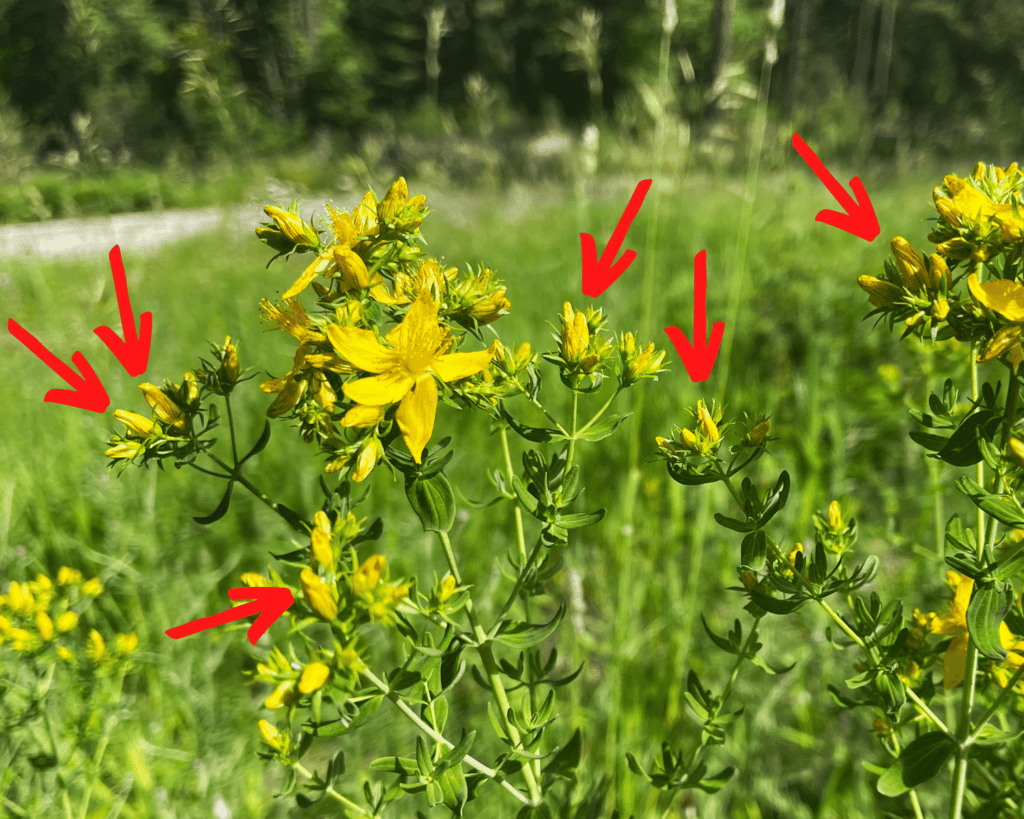
Harvesting
Fresh or dry?
Mature buds or entire flowering tops?
These are the burning questions.
Hypericin is not well preserved when the plant is dried, which is why infused oils using St. John’s wort are usually made from fresh plants rather than dried. Some herbalists dismiss dried St. John’s wort as a waste of time, and work with fresh exclusively.
Herbalist Michael Moore considers the dried plant is “far less active,” but notes that it can still be useful as a standard infusion.
Matthew Wood instructs that mature flowers should be picked fresh in mid-to-late summer “on a long, hot, dry summer day” when they’re dry (not moist).
On the other hand, Richo Cech states in his book Making Plant Medicine that tinctures made from dried St. John’s wort are an “extremely effective” preparation. That said, his instructions for making a dried St. John’s wort tincture specify “recently dried,” so that may be an important distinction. Cech recommends using 75% (aka 151 proof) to tincture recently dried St. John’s wort.
Cech also points out that preparations that focus only on the buds/flowers will miss out on flavonoids in the leaves that actually enhance the effectiveness of the constituents found in the buds and flowers (such as hypericin and hyperforin).
So as usual, there are a variety of opinions about the best way to work with St. John’s wort.
I personally believe that the synergy of the whole plant is always going to be more effective than any one isolated part. Nature knows best, ya know? Yes, the bulk of SJW’s active constituents are concentrated in the flowers and buds, but maybe there is something in the leaves (like the flavonoids Cech mentioned) that works to augment those compounds beyond what they can do in isolation.
For infused oils and alcohol tinctures, I usually use a mix of open flowers, buds and leaves, and have gotten good results (as well as a rich red pigment) from simply taking the tops off of young plants.
If you want a more hypericin-rich and brightly colored oil/tincture, then by all means, be selective about those unopened buds. It can be pretty labor intensive, though, depending on how hard you have to look for the buds. Thanks to scarcity and an infestation of St. John’s wort beetles, it took me quite awhile (and two separate locations) to collect enough for this 1/2-pint jar:
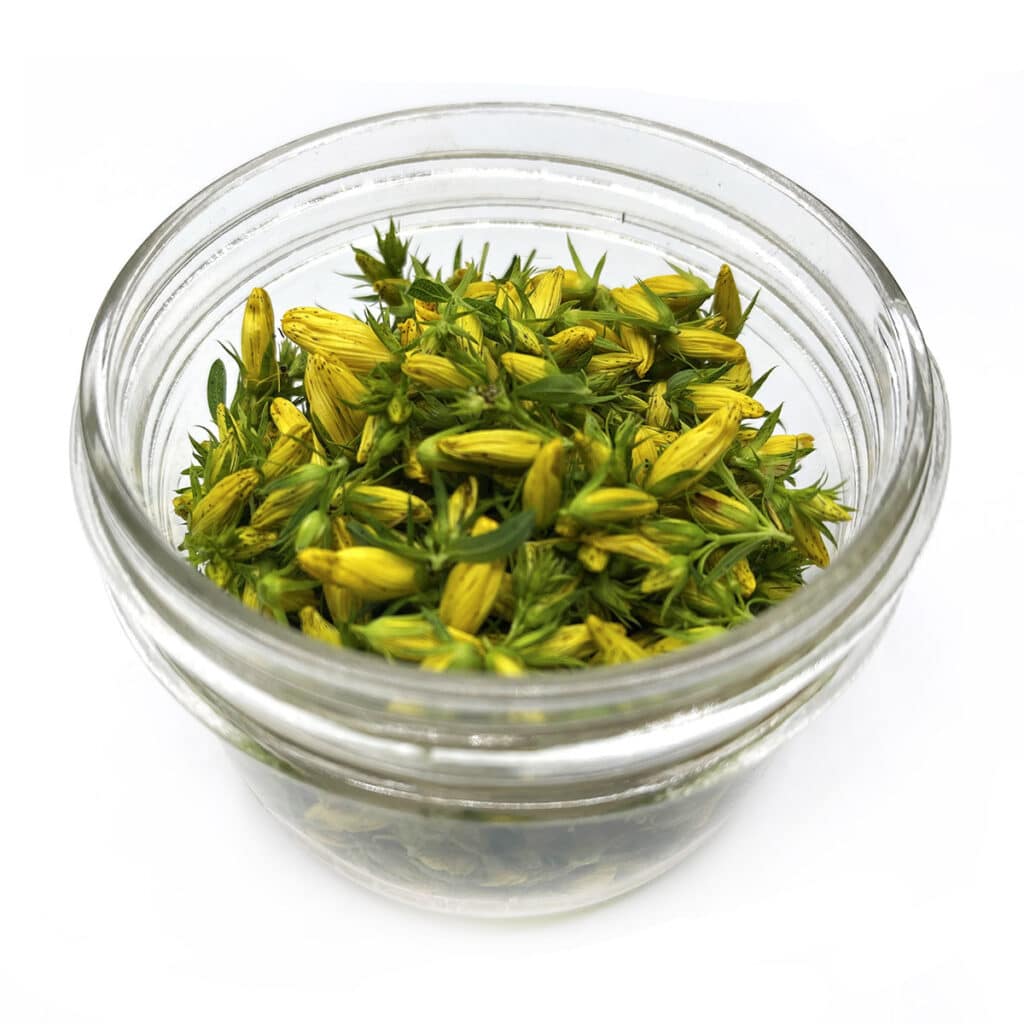
Hypericated (fresh) preparations
However (and whenever) you choose to harvest the herb, you can make an infused preparation by following the folk method for infusing oil or tincturing with alcohol.
Generally speaking, for fresh plant matter, you’ll want to fill your jar to the top with flowers/buds/leaves. You can muddle or chop them up to bruise and expose more surface area, which will aid the maceration process.
To tincture, cover with alcohol and follow the folk method of tincturing. Richo Cech recommends using 100% alcohol (aka 190 proof) for fresh plant tinctures.
For a hypericated oil, cover fresh plant matter with your oil of choice (I used tallow, natch) and follow the guidelines for a hot oil maceration. For a more potent oil, you can also do an alcohol intermediary oil infusion.
Fresh St. John’s wort buds covered in warm tallow before:
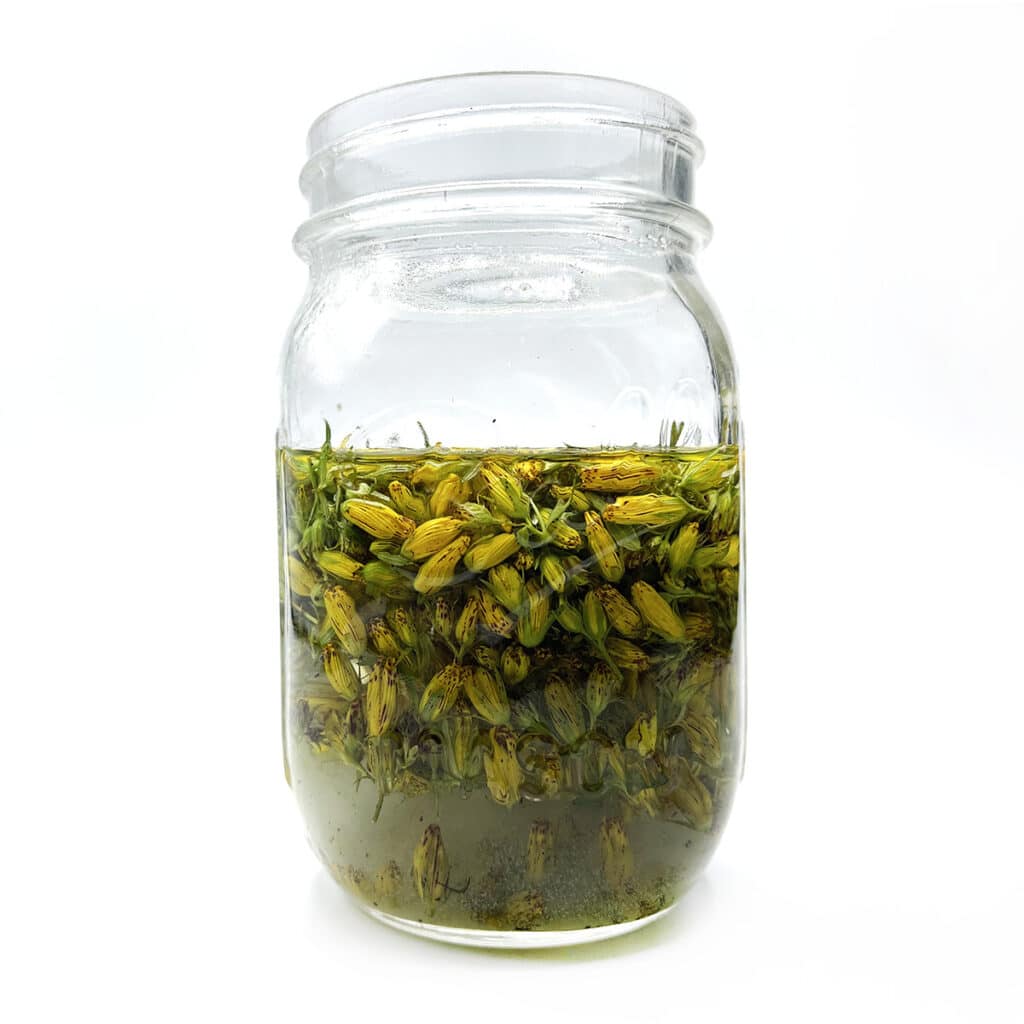
…and after spending a week in a warm (~110F) dehydrator cabinet:
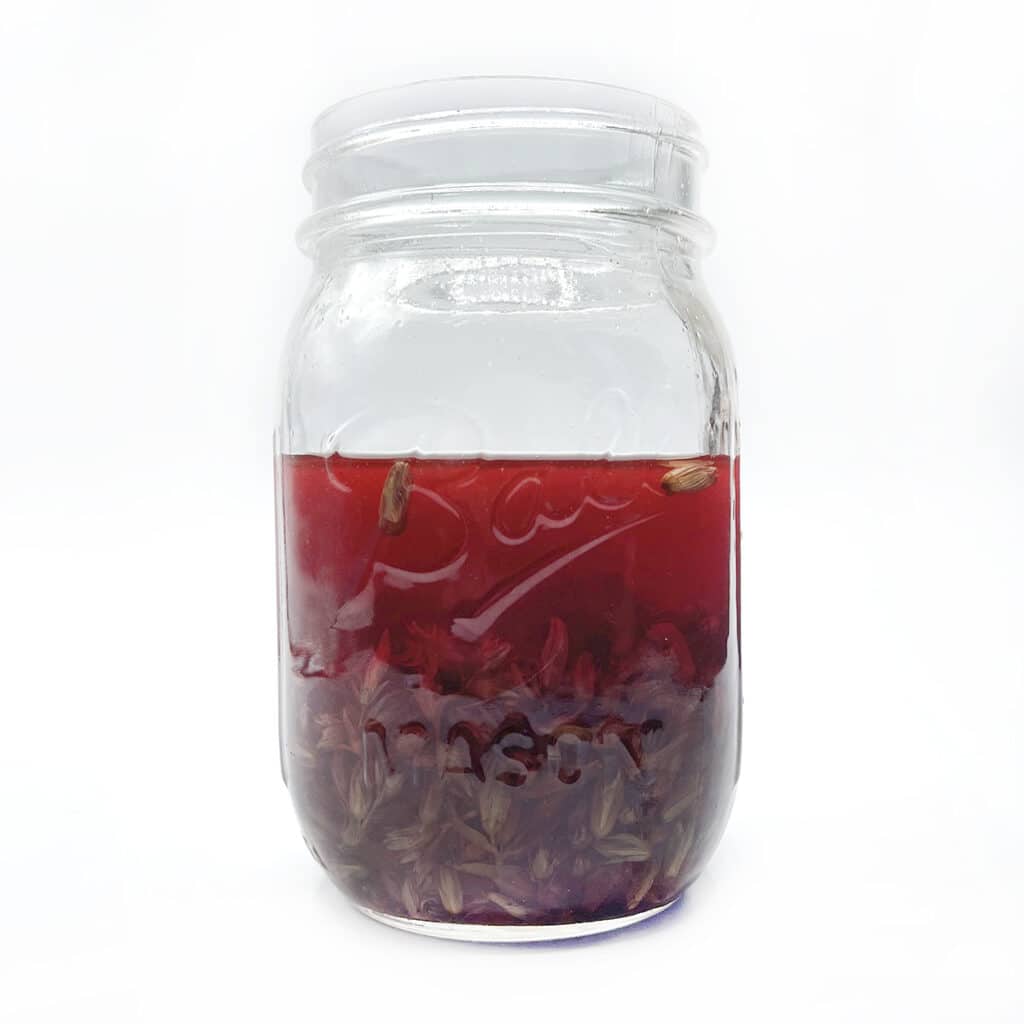
Wowza! So pretty. ♥ ♥ ♥
I’m planning to use my St. John’s wort-infused tallow to make a CBD salve intended to help with muscle and nerve pain.
Stay tuned for the recipe!

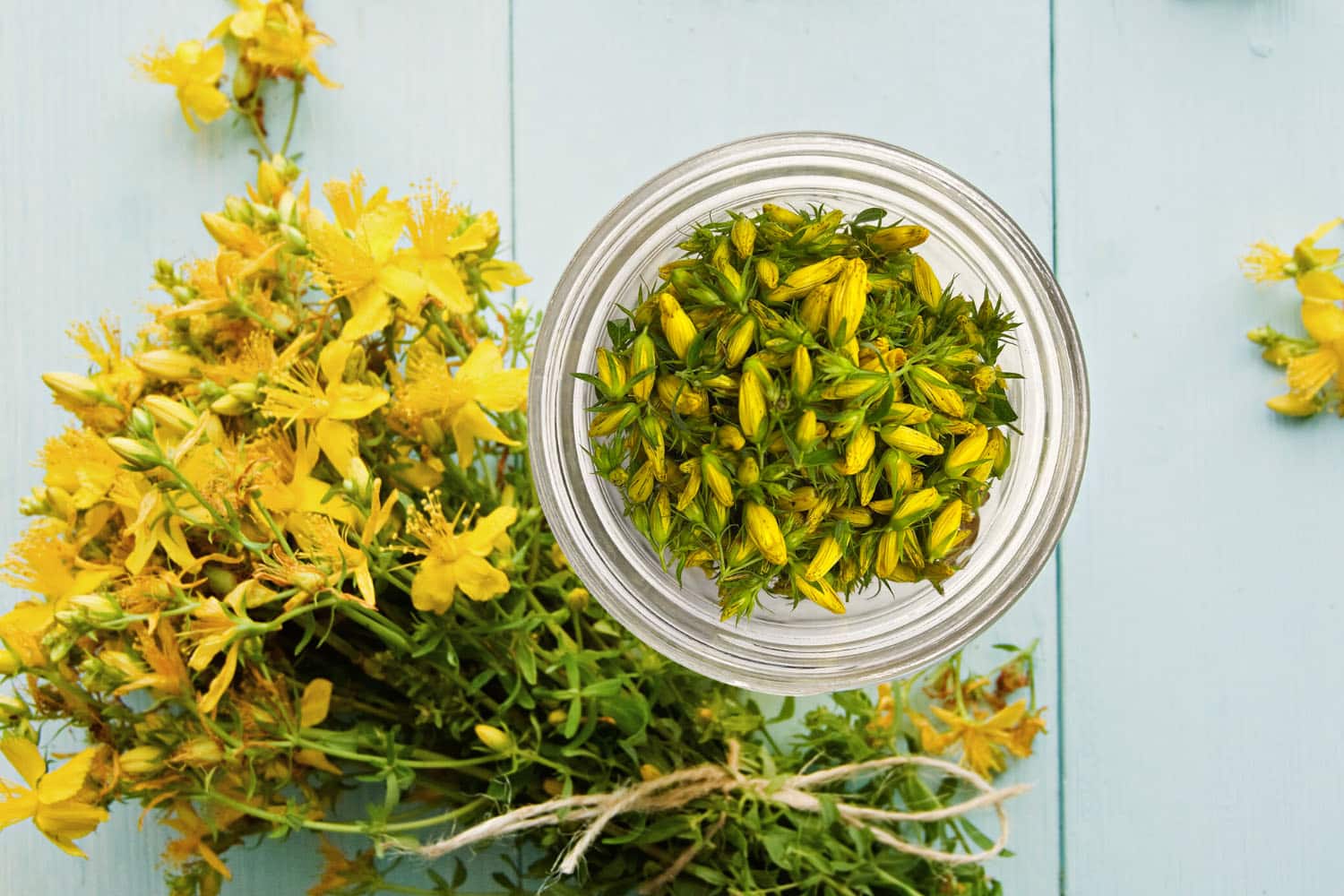


2 Responses
Love that you are using tallow to create infused SJW goodness!!! 🌿 are you infusing the SJW into the tallow fresh? And if so, are you then keeping the tallow in the fridge?
Since hypericin is not well preserved in dried SJW (and since it grows like mad all around my house), I use fresh and I don’t refrigerate it. The heated infusion (~2 weeks for fresh St. John’s wort) effectively removes any moisture that would cause spoilage. Just be sure to crack the lid of the slow cooker (or don’t use a lid at all) to allow moisture to evaporate during the infusion process. If using a warm oven or dehydrator cabinet, leave the jars uncapped to allow moisture to escape.